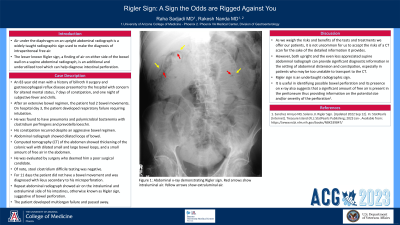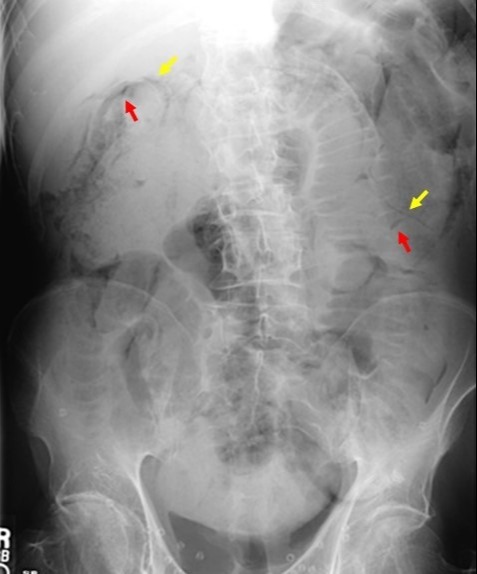Monday Poster Session
Category: Colon
P1638 - Rigler Sign: A Sign the Odds Are Rigged Against You
Monday, October 23, 2023
10:30 AM - 4:15 PM PT
Location: Exhibit Hall

Has Audio

Raha Sadjadi, MD
University of Arizona College of Medicine
Phoenix, AZ
Presenting Author(s)
Raha Sadjadi, MD1, Rakesh Nanda, MD, FACG2
1University of Arizona College of Medicine, Phoenix, AZ; 2Phoenix VA Medical Center, Phoenix, AZ
Introduction: Air under the diaphragm on an upright abdominal radiograph is a widely taught radiographic sign used to make the diagnosis of intraperitoneal free air. The lesser known rigler sign, a finding of air on either side of the bowel wall on a supine abdominal radiograph, is an additional and underutilized tool which can help diagnose intestinal perforation.
Case Description/Methods: An 83 year old man with a history of billroth II surgery and gastroesophageal reflux disease presented to the hospital with concern for altered mental status, 7 days of constipation, and one night of subjective fever and chills. After an extensive bowel regimen, the patient had 2 bowel movements. On hospital day 3, the patient developed respiratory failure requiring intubation. He was found to have pneumonia and polymicrobial bacteremia with clostridium perfringens and prevotella loeschii. His constipation recurred despite an aggressive bowel regimen. Abdominal radiograph showed dilated loops of bowel. Computed tomography (CT) of the abdomen showed thickening of the colonic wall with dilated small and large bowel loops, and a small amount of free air in the abdomen. He was evaluated by surgery who deemed him a poor surgical candidate. Of note, stool clostridium dificil testing was negative. For 11 days the patient did not have a bowel movement and was diagnosed with ileus secondary to his microperforation. Repeat abdominal radiograph showed air on the intraluminal and extraluminal side of his intestines, otherwise known as rigler sign, suggestive of bowel perforation. Unfortunately the patient developed multiorgan failure and passed away.
Discussion: As we weigh the risks and benefits of the tests and treatments we offer our patients, it is not uncommon for us to accept the risks of a CT scan for the sake of the detailed information it provides. However, both upright and the even less appreciated supine abdominal radiograph can provide significant diagnostic information in the setting of abdominal distension and constipation, especially in patients who may be too unstable to transport to the CT. Rigler sign is an undertaught radiographic sign. Not only is it useful in identifying possible bowel perforation, but its presence on x-ray also suggests that a significant amount of free air is present in the peritoneum thus providing information on the potential size/severity of the perforated viscus.

Disclosures:
Raha Sadjadi, MD1, Rakesh Nanda, MD, FACG2. P1638 - Rigler Sign: A Sign the Odds Are Rigged Against You, ACG 2023 Annual Scientific Meeting Abstracts. Vancouver, BC, Canada: American College of Gastroenterology.
1University of Arizona College of Medicine, Phoenix, AZ; 2Phoenix VA Medical Center, Phoenix, AZ
Introduction: Air under the diaphragm on an upright abdominal radiograph is a widely taught radiographic sign used to make the diagnosis of intraperitoneal free air. The lesser known rigler sign, a finding of air on either side of the bowel wall on a supine abdominal radiograph, is an additional and underutilized tool which can help diagnose intestinal perforation.
Case Description/Methods: An 83 year old man with a history of billroth II surgery and gastroesophageal reflux disease presented to the hospital with concern for altered mental status, 7 days of constipation, and one night of subjective fever and chills. After an extensive bowel regimen, the patient had 2 bowel movements. On hospital day 3, the patient developed respiratory failure requiring intubation. He was found to have pneumonia and polymicrobial bacteremia with clostridium perfringens and prevotella loeschii. His constipation recurred despite an aggressive bowel regimen. Abdominal radiograph showed dilated loops of bowel. Computed tomography (CT) of the abdomen showed thickening of the colonic wall with dilated small and large bowel loops, and a small amount of free air in the abdomen. He was evaluated by surgery who deemed him a poor surgical candidate. Of note, stool clostridium dificil testing was negative. For 11 days the patient did not have a bowel movement and was diagnosed with ileus secondary to his microperforation. Repeat abdominal radiograph showed air on the intraluminal and extraluminal side of his intestines, otherwise known as rigler sign, suggestive of bowel perforation. Unfortunately the patient developed multiorgan failure and passed away.
Discussion: As we weigh the risks and benefits of the tests and treatments we offer our patients, it is not uncommon for us to accept the risks of a CT scan for the sake of the detailed information it provides. However, both upright and the even less appreciated supine abdominal radiograph can provide significant diagnostic information in the setting of abdominal distension and constipation, especially in patients who may be too unstable to transport to the CT. Rigler sign is an undertaught radiographic sign. Not only is it useful in identifying possible bowel perforation, but its presence on x-ray also suggests that a significant amount of free air is present in the peritoneum thus providing information on the potential size/severity of the perforated viscus.

Figure: Figure 1. Yellow arrows show extraluminal free air. Red arrows show intraluminal air.
Disclosures:
Raha Sadjadi indicated no relevant financial relationships.
Rakesh Nanda indicated no relevant financial relationships.
Raha Sadjadi, MD1, Rakesh Nanda, MD, FACG2. P1638 - Rigler Sign: A Sign the Odds Are Rigged Against You, ACG 2023 Annual Scientific Meeting Abstracts. Vancouver, BC, Canada: American College of Gastroenterology.
